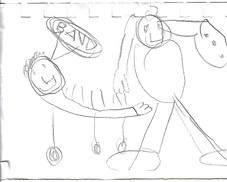Children and Chinese Medicine
Chinese Medicine is an approach to illness and health that has a specific indication in children: it is highly effective in acute diseases, it allows to reduce the taking of conventional drugs in serious chronic pathologies, it works very well to prevent illness and to reinforce constitution when children get easily sick.
Children correspond to spring, dawn, the rising of yang inside yin. Therefore a characteristic of their energetic quality is the rapidity of movement: they get sick very easily, but they respond to therapeutic treatment just as easily.
Main indications are:
-
prevention and cure of recurrent respiratory infections;
-
infant acute abdominal pain, constipation, diarrhoea;
-
poor appetite, lassitude;
-
common cold, cough, catarrh, asthma;
-
poor sleep, night crying, restlessness, agitation, hyperactivity;
-
retarded psycho-physical development.
Paediatric tuina belongs to Chinese Medicine: it is based on the same physiology and diagnosis principles, it is part of the training of traditional doctors, it is widely used in today’s hospitals in China.
Individual sequences are usually taught to parents, to be applied at home.
As for acupuncture, there is no contraindication about its use. The needles are much thinner, the number of points is small, the stimulation time is short.
Elisa's Paediatric Training
Her first contacts with TCM and children were in 1983, at the Academy of Acupuncture of Beijing. Since then, in her private practice she used acupuncture in paediatrics, thanks also to Julian Scott’s teachings. Later on she had the chance to know more about paediatric tuina and also to see qigong treatment performed on children, at Xiyuan Hospital, Beijing, in 1992, by Lu Guangyun.
Her main training was with Yin Ming, at the TCM Paediatric Departments of the Provincial Hospital of Nanjing in 1999 and 2000, backed up by the work with Zhang Sufang, at the Provincial Hospital of Jinan, in 2006.
In 2002 she set up a Children's Clinic in her co-founded School "Associazione MediCina", with Julian Scott’s support and run it for two years. In 2005 founded the Children's clinic Xiaoxiao.
Xiaoxiao
The Children's clinic Xiaoxiao was first established in 2005 in Milan, it operates once a week.
It runs some pilot projects:
From 2005 “Treatment and prevention of recurrent respiratory diseases”
From 2008 “Project Calm” (hyperactivity, attention difficulties or sleep disturbances).
From 2011 “Chronic Pain”: seriously ill children (such as tetraplegia, hydrocephalia, spinal muscolar atrophy), referred by a paediatric hospital.
From 2018 "Babies born via ART"
Other frequent complaints: mainly nocturnal enuresis, atopic eczema, infantile colics, retarded development, poor appetite, constipation, gastro-oesophageal reflux, headache.
Working with parents
Parents are involved by teaching them a sequence of paediatric tuina specific to their child to perform at home: it supports to the work carried out in the clinic, parents feel more empowered, children experience that it is possible to have the resources within oneself.
Evaluation and research
Since 2007 data is recorded in a database to be used for research.
In 2012 we started to collect photos of all the children' tongues, except babies.
There is a follow-up after 6-12 months, with specific questions regarding the main complaint, other problems the child may have had and the application of tuina at home. We have received answers from 70%
After the end: a 4-items questionnaire to parents to evaluate: their experience in the clinic, treatment results, use of tuina at home, if they would advise Xiaoxiao + any comment or suggestion they may have.
Training
Practitioners can develop their clinical knowledge by working with real children and parents.
Up to June 2018, 127 trainees have attended basic or advanced training.
Team
The core group has evolved over the years, but Annamaria Petrarolo has coordinated the clinical work and has run the database since 2007. Monica Curioni, Liliana Sechi, Paolo Balossi and Raffaella Rampoldi are currently the other senior colleagues.
Publications in English about Xiaoxiao
“Pediatrics in Chinese Medicine", Donica 2011 (ch. 13)
Articles
“Paediatric Tuina and Acupuncture: The Xiaoxiao Clinic in Milan”
(Journal of Chinese Medicine, n.85, 2007)
“Acupuncture and Tuina for Hyperactive Children”, (Journal of Chinese Medicine, n.94, 2010)
“Children and Water-Fire Unbalance” (Jing-Shen, n.6, 2010)
“Basis of Paediatric Tuina” (The Lantern, vol.VIII, n.1, 2011)
“Chinese Medicine at Ilula, Tanzania: an Experience in Learning”, European Journal of Oriental Medicine, vol.7, n.2, 2012
"Treating Children" (Journal of Chinese Medicine, n.113, 2017)
“ART babies & Chinese medicine” (Acu., n.20, 2018) (Reprinted with thanks to British Acupuncture Council’s member magazine)







